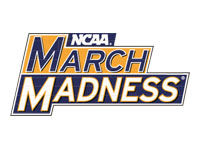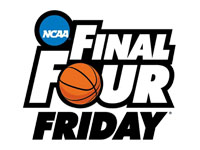March Madness

When it comes to major US sporting tournaments, it is hard to argue with the NCAA Men’s Division Basketball Championship, which is more commonly referred to as March Madness. This is when 68 of the best college basketball teams from around the country take part in a single elimination tournament every Spring. The first tournament of this nature took place in 1939 and it is also known as the Big Dance.
Have a look at our comprehensive March Madness Betting Guide. We encourage you to read this guide if you are new to – or want to know where to wager on the NCAA Basketball tournament.
The tournament is comprised of the champions from all of the thirty two Division 1 conferences, who gain automatic entry to March Madness, and thirty six teams who are invited to the event. The invitation process is carried out by a selection committee from the NCAA. This creates 68 teams and these teams are placed into four regional sections. The flow of the tournament can be seen with the bracket, which predetermines the route and opponents a winning team will face.
| # | Betting Site Review | % | Bonus | Visit Betting Site | |||
|---|---|---|---|---|---|---|---|
| 1 | Everygame Review | $20 free bet | Everygame | ||||
| 2 | Bovada Review | 50% | $250 | Bovada | |||
| 3 | BetOnline Review | 25% | $1000 | BetOnline | |||
Bet365 T&Cs: New Customers only. Bet £10* & Get £30* in Free Bets. Sign up, deposit between £5* and £10* to your account and bet365 will give you three times that value in Free Bets when you place qualifying bets to the same value and they are settled. Free Bets are paid as Bet Credits. Min odds/bet and payment method exclusions apply. Returns exclude Bet Credits stake. T&Cs, time limits & exclusions apply.
The regions can change from year to year
Every team is ranked within their own region. The region names can change from year to year and they are generally decided based on the rough geographical base of the teams that are involved.
The different rounds of March Madness are:
- The First Four
- The Second Round, commonly referred to as the Round of 64
- The Third Round, commonly referred to as the Round of 32
- The Regional Semi-finals, referred to as the Sweet Sixteen
- The Regional Finals, referred to as the Elite Eight
- The National Semi-finals, referred to as the Final Four
- The National Championship
All of the teams are ranked in their own region and theoretically, all of the teams involved in the process are ranked from 1-64 by the committee. This is therefore a large activity for the committee to undertake, especially when you consider that 36 teams have to be determined as well.
Many teams are left unsure if they will be participating in March Madness until Selection Sunday. Selection Sunday is the date when the seedings, brackets and qualifiers are formally announced. This is now a major event and is broadcast on TV, involving fans to a greater degree than ever before.
In addition to selecting teams, splitting them into regions and ranking them, there are other considerations for the selection committee to think of. There is a pressure, whenever possible, to place teams into the brackets in such a manner that teams from the same conference are unable to face each other until the finals for the regional part of the tournament. There is also a pressure to ensure that teams facing off in the round of 64 or round of 32 are not replaying a game from the previous season.
The First Four sees the four lowest ranked invited teams and the four lowest ranked conference champions play against each other. There are eight teams at this stage but there are four ties with four spots up for grabs in the second round.
After the conclusion of this round, there are 64 teams left and with four regions, there is a clear ranking of 1 through to 16 of teams in every region. The seeding for this round is as follows:
- The 1st ranked team plays the 16th ranked team
- The 2nd ranked team plays the 15th ranked team
- The 3rd ranked team plays the 14th ranked team
- The 4th ranked team plays the 13th ranked team
- The 5th ranked team plays the 12th ranked team
- The 6th ranked team plays the 11th ranked team
- The 7th ranked team plays the 10th ranked team
- The 8th ranked team plays the 9th ranked team
The bracket is created in such a fashion that the winner of the tie between the 1st and 16th team plays the winner of the 8th and 9th team. They will eventually take on the winners of the tie between the 5th and 12th seeds and the 4th and 13th seeds.
The bottom half of the draw sees the winner of the 2nd and 15th teams playing off against the winner of the 7th and 10th teams. The other tie evolves from the winners of the 6th and 11th teams playing off against the 3rd ranked and 14th ranked teams.
The Second round provides a lot of basketball action
Half of the Second Round games are played on the Thursday night, with the remaining half being played on the Friday night.
By the close of play on Friday night, there are 32 teams left in the tournament and play continues on Saturday. The teams that triumphed on Thursday play their Third Round tie on Saturday while the teams that triumphed on Friday play their Third Round tie on Sunday. By the close of play on Sunday evening, there are 16 teams left. This takes the teams through to the Regional Semi-Finals, which is commonly referred to as the Sweet Sixteen.
These 16 teams play off on Thursday and Friday, following the pattern of the previous week. By Friday evening, 8 teams will have progressed to the Regional Finals or the Elite Eight.
The four winning teams from Thursday play their Regional Finals on Saturday while the four winning teams from Friday play their Regional Finals on Sunday. By the close of play on Sunday night, there are four teams left in the tournament.
This takes the tournament to the National Semi-Finals or the Final Four.
The order process for the semi-finals is determined by the 1-4 ranking of the original Regional seed in the initial bracket, not the rankings of the four teams themselves.
The 2012-13 Final Four

The Final Four, and the Final, is played out in one venue with the Georgia Dome in Atlanta being the venue for the 2012-13 season. The attendance on Final Four day was 75,350 while the stated attendance for the Final itself was 74,326.
The four teams placed in the Final Four for the 2012-13 season were:
- Louisville, representing Midwest
- Wichita State, representing the West
- Michigan, representing the South
- Syracuse, representing the East
Louisville took on Wichita State, winning 72-68 while Michigan defeated Syracuse 61-56 in the other semi-final. In the final, Louisville defeated Michigan by 82 to 76.
The first NCAA Division 1 Tournament
The very first NCAA Division 1 tournament took place back in 1939. By modern standards, this tournament was a very simple affair with 8 teams battling it out for the title.
The 8 teams were:
- Villanova
- Brown
- Ohio State
- Wake Forrest
- Oregon
- Texas
- Oklahoma
- Utah State
The tournament started with the quarter finals, proceeded to the semi-finals, a third placed play-off in the East region and the final. In the final, Oregon from the West Region defeated Eastern side Ohio State by a score of 46 to 33. This made Oregon the first ever NCAA winners.
NCAA Records

As at 2013, UCLA are the most successful team in the NCAA Division 1. This is because they have 11 titles. 10 of these titles were won between 1964 and 1975, including an incredible 7 in a row between 1967 and 1973. The team’s most recent triumph came back in 1995. It is no surprise that John Wooden, the UCLA Head Coach during their 60s and 70s golden era is the coach with the best record at the NCAA Division Championships with 10 titles.
Next in line for most successes is Kentucky who have 8 triumphs. The team won in 1948, 1949 and 1951 with their most recent success coming in 2012. Next in line is Indiana, who have 5 triumphs, although their most recent success came in 1987.
With respect to successes by Conference, the most successful conference is the Pacific-12 Conference who can boast of 15 conferences. It is no surprise to learn that this conference plays host to UCLA.
Next in line is the Atlantic Coast Conference who can boast of 12 wins while the Southeastern Conference can boast of 11 championship wins.